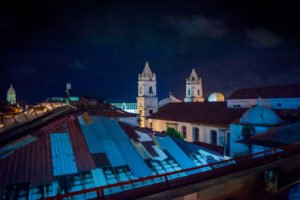 (The Miscellany News) Whenever I told people that I was going to Panama, they always asked if I was going to the canal. And while I did go to the Miraflores Locks and watched giant freighters pass through one of the greatest engineering feats in the world, I also did so much more during my three-day stay in Panama City.
(The Miscellany News) Whenever I told people that I was going to Panama, they always asked if I was going to the canal. And while I did go to the Miraflores Locks and watched giant freighters pass through one of the greatest engineering feats in the world, I also did so much more during my three-day stay in Panama City.
One of the obviously touristic sites of Panama City is Casco Antiguo, a historical section of the city built high up on sea walls. Although there are tons of shops selling woven bracelets, wooden animals and old Panama license plates, the architecture of the city is also fascinating. Once part of the Spanish colony, many of the churches in the area are classic Spanish architecture.
However, after the Panama region was a Spanish colony parts of the area became a French colony, meaning that a lot of the architecture in the city is French as well. Seeing the contrast between the Spanish and French architecture in one city is a testament to the region’s complex colonial history.
There are also important political landmarks in Casco Antiguo, like the President’s Palace and the French Embassy. Right nearby the embassy, there was a huge outdoor display of pictures of French artworks nearby one of the highest seawalls overlooking the modern skyline of Panama City. From this same seawall it is possible to see the colorful roof of the Biomuseo, a large museum dedicated to the history of Panama and the biodiversity of the wildlife.
A walk through the museum taught me about the species visible in Panama and their various statuses as endangered and threatened species. The views are beautiful and the walk-through timeline explains how the creation of Panama created such incredibly diverse forests and oceans. To those traveling to Panama, I recommend traveling beyond the city and the canal to areas like Casco Antiguo and the Biomuseo. There is much more to Panama City than the canal zone.
